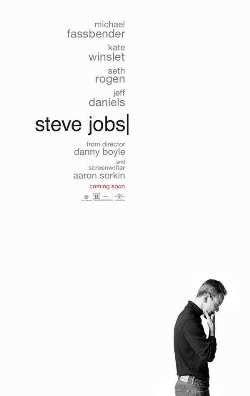4.5 out of 5 stars
As the face of the digital revolution, Steve Jobs no doubt warrants a good biopic. Yet after the last film with Ashton Kutcher, which includes a lazily composed script that makes it mediocre at best, and the excess of documentaries on Jobs in recent years, perhaps filmmakers have devoted too much attention to the man who gave us the iPhone. However, leave it to screenwriter Aaron Sorkin to deliver where the last Hollywood attempt failed.
Between Sorkin’s Shakespearean dialogue and Michael Fassbender’s kinetic performance, “Steve Jobs”definitely rises above the multiple other movies made about the late CEO and co-founder of Apple, providing audiences with an in-depth look at the man and the myth, but mostly at the myth.
Split into three parts, the film shows us a behind-the-scenes look at the unveiling of three of Jobs’ products. Playing out in real time and with only a handful of flashbacks, the script is radically different from other biopics, as most provide an overview of their subjects’ lives.
When we first meet Jobs in 1984 at the unveiling of the Macintosh, his demeanor is as cruel and heartless as many of the documentaries about him have suggested. He barks orders at his marketing manager Joanna Hoffman (Kate Winslet), tries to ignore his ex-girlfriend Chrisann (Katherine Waterson) while denying that their daughter is his, and despite the pleas of his longtime friend and collaborator Steve Wozniak (Seth Rogen), he refuses to mention his engineering team in his speech.
It’s an electric introduction for an electric film and is made all the better by director Danny Boyle’s equally captivating camerawork, which swoops and swerves along the confined interiors of the auditorium, bringing to mind the seemingly endless tracking shot in last year’s “Birdman.”
As the story shifts to Jobs’ dismissal from Apple at the hands of then CEO John Sculley (Jeff Daniels) and the unveiling of his NeXT Cube in 1988, we see a more humanized version of him begin to form. With his daughter Lisa (portrayed by three different actresses in the film) being the primary catalyst for his evolution, two key scenes between them take place here and at the end as he prepares to launch the iMac. These quiet and intimate moments are the only break we get from the loud and inexplicably rapid pace of the film.
While Sorkin is a master of biopics (“The Social Network”) and hard-edged dramas in both film and television (“A Few Good Men,” “The Newsroom”), Boyle’s body of work is as diverse as one can imagine. From “Trainspotting” to “Slumdog Millionaire” to “28 Days Later,” he is a filmmaker who seems willing to tackle virtually any story that says something about the human condition. Though “Steve Jobs” originally had David Fincher set to helm it with Christian Bale in the lead, arguments between Fincher and Sony eventually led to Boyle getting the job. Bale dropped out on his own.
Perhaps Boyle’s most interesting directorial decision, or gimmick depending on how you look at it, is to use different cameras in each act of the film so as to parallel the evolution of Jobs’ technological advancements. He goes from using 16mm film to 35mm to digital, a tactic that critics will either applaud or groan at.
In what is perhaps Fassbender’s best performance yet in his career, he no doubt captures every bit of the mythological components of his character. During an overtly fictionalized and heated dialogue between him and Wozniak, in which his friend questions the authenticity of his intelligence, this scene mirrors any number of Shakespearean tragedies in which the hero loses everything in the pursuit of power. On that note, Fassbender is also starring in an upcoming film adaptation of “Macbeth” which is set to release in December.
“Steve Jobs” will surely be a major Oscar contender on multiple fronts, and rightfully so. With its sophisticated filmmaking and electrifying performances, it captures the life of a man who admits that his inventions were better than him.








